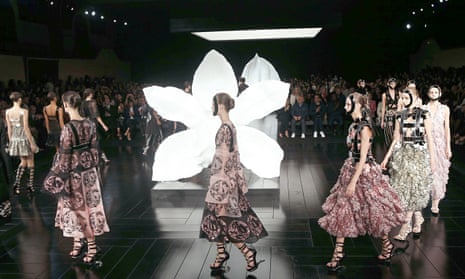Two huge casts of white orchids made by British artist Marc Quinn – one male, the other female – filled the space for Alexander McQueen’s spring/summer 2015 show at Paris fashion week on Tuesday evening. They were contrasted against the black shiny parquet flooring to give something of the Japanese lacquered box feel to the space.
It was a neat backdrop for a collection that put Japan back on the McQueen map. Rather than the frenetic neon of present-day Tokyo, it was the traditional arts and crafts in the frame here. The first look was a black cape appliquéd with bold pink chrysanthemums, and a frieze–like geometric pattern across the centre. Others that followed included extraordinary python dresses with the leather handcut into red and black patterns like the lacquer boxes, and looser dresses with wide sleeves like kimonos. The shiny black masks worn around the models’ faces hinted at the look of kabuki, also an inspiration and the overall effect had the crisp colour contrasts of the traditional Japanese aesthetic, but given a McQueen spin. See kinky boots laced up the knee, with a backless perspex heel, and armour–like detailing across the bust of chiffon gowns. The final few dresses, with full skirts of palest pink and white organza cut into tiny feather shapes, were feats of craftsmanship.
Creative Director Sarah Burton said afterwards that she had always been influenced by Japan – from early in her McQueen career, when she used to go “three or four times a year.” A designer who gets a kick out of making, she said “it’s the pride in craftsmanship and the innovation” that appeals and pointed to two designs with obi belts using “silk woven for us in Japan.”
Burton was keen to point out that, while the show and its backdrop was somewhat theatrical, the collection was commercial – with the majority of what was on the catwalk eventually heading to the shop floor. “Almost all of it is for sale,” she said, joking that “I sound like a used car salesman.”
Hardly – but she did sound different from McQueen himself. If his shows were dramatic pieces of theatre, rather than a showcase of clothes to wear, Burton is walking the line between the two. His point of view always looms large in collections that bear his name, though. Burton knows it by heart – working side by side with him for so long means it’s arguably hers too. This collection could be seen as a sequel to spring/summer 2001 – also inspired by Japan – and the McQueen-designed dress worn by singer Björk on the cover of Homogenic in 1997.
Four years after McQueen’s death and now more accustomed to the limelight – designing the Duchess of Cambridge’s wedding gown in 2011 must have been a baptism of fire – a new era for the brand is slowly emerging, with the Duchess something of a figurehead. A mother of twins who today was dressed in ballet flats and loose combat pants, Burton’s clothes have the drama but are more female-friendly. Her take on those Quinn sculptures spoke volumes. “I loved the scale and the size but also their fragility – particularly the female one,” she said. “Something so huge but fragile as well.”
A distinction between the past and present comes at a good time for the brand. Spring 2015 will see McQueen’s work in the spotlight when the Victoria & Albert museum hosts Savage Beauty, the retrospective first shown at the Metropolitan Museum of Art in New York in 2010. The exhibition was a huge success and had queues around the block. The same is likely to happen here – especially with a new generation of twentysomethings keen to discover the designer behind that global name.
Alexander McQueen the brand is robust under Burton. It is majority owned by Kering, the luxury conglomerate that also owns Gucci, Bottega Veneta and Saint Laurent. While Hedi Slimane’s Saint Laurent is likely to remain the commercial star after Monday night’s show wisely continued on the rockn’roll track that has seen the label’s sales grow by 27% in the second quarter of 2014, McQueen is consistently a success. Grouped with other smaller brands, along with Stella McCartney, revenue across these brands was up 8% in the same period.

Comments (…)
Sign in or create your Guardian account to join the discussion